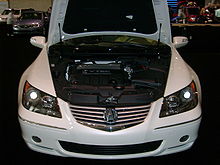Acura RL
The second-generation Acura RL was a rebadged version of the fourth-generation Honda Legend, introduced to the North American market in September 2004, as a 2005 model.
As a result, the longitudinal placement of the engine allowed for a smaller turning radius and easy in-town maneuverability, as well as 56/44 front/rear weight distribution for the 1996MY.
[11] In 2001, the 2002 model year 3.5RL received painted lower trim and mudflaps along with redesigned 7-spoke alloys and a newer, sportier suspension setup which included new springs, dampers, larger and solid sway bars, and new front upper control arms.
[13] For the 2004 model year, the 3.5RL offered as standard equipment a revised navigation system and integrated satellite radio in the Continental United States in addition to a redesigned center console and chrome door lock pulls.
[15] The RL was equipped with unique five-spoke 17-inch alloy wheels and Michelin Pilot HX MXM4 245/50R17 98V[15] all season grand touring tires.
The ANC sent information to the sound system to create a precisely shaped and timed reverse-phased audio signal from the door speakers and the subwoofer.
Heating and air conditioning systems were tied into a solar sensor and GPS positioning so that cabin temperature remained constant in a mixed sun and shade situation.
The Alpine Electronics DVD-based navigation system was integrated with an 8-inch LCD display and a multi-use Interface Dial, which could move up, down, left and right like a mouse, turn like a knob, scroll through preset menus, and click when pushed to act as a selector button.
Other new RL features included the Active Front Lighting System, in which the high intensity discharge headlamps swiveled in concert with the steering up to twenty degrees, for improved night cornering vision.
The new RL featured extensive aerodynamic design treatment including details such as flush side glass, plus underbody covers and diffusers to reduce lift, resulting in a very low drag coefficient of 0.29.
More aggressive "aero" look body work was also standard, and a revised trunk decklid spoiler was made available as a dealer installed option.
[23] Engine emissions were reduced to meet the stricter U.S. Environmental Protection Agency (EPA) TIER 2 – BIN 5 and California Air Resources Board ULEV-2 standards.
The MMC RL suspension was upgraded with higher-rate coil springs, larger diameter anti-sway bars and stiffer bushings all around.
Simulated woodgrain trim was added to the steering wheel and the top of the shifter, to emphasize the RL's upscale aspirations compared to its less costly TL and TSX siblings.
Additional insulation, improved acoustic isolation, windshield design, and a new implementation of the Active Noise Cancellation system (ANC) combined to make the 2009 RL's interior quieter in a variety of conditions.
An additional microphone as well as some switchable directionality was added to the HFL (Hands Free Link) and Voice Activated Navigation and Convenience controls.
Parking/backup sensors had been available in the North American market as a dealer installed option since the second generation Acura RL's introduction in late 2004.
The resonator served to suppress specific frequencies between 100 and 500 hertz, and in combination with increased floorboard insulation, decreased interior noise by 1.3 dB, or 15%.
[40] In a comparison of 2006–2007 model year mid-luxury sedans with all-wheel drive (prices ranging from $60,000 to 65,000 CAD), the RL compared favorably to a Mercedes-Benz E300 4MATIC and a BMW 528xi with xDrive.
Among Japanese luxury flagships marketed in America during the first six months of 2010, Acura sold only 872 RLs, compared to 5,650 Lexus LS and 6,602 Infiniti M sedans.
[45] Enthusiasts and dealers said that the RL was not competitive because it lacked the full-size dimensions (the back seat was regarded as tight for a car of this size),[46] a V8 engine performance option, and the better handling and balanced rear-wheel drive of its larger rivals in the mid-luxury segment.
[36][44][49] The RL's styling, while generally considered handsome, was not viewed as inspiring or passionate enough to alert buyers to its technological features or stand out in a crowded field, and the 2009 model was criticized for its "power plenum" grille, a bright horizontal pentagon of chrome that formed a shield across the upper center.
[43][44] Late in its production lifespan the RL also faced competition from the Hyundai Genesis which was less expensive yet similarly refined, while featuring rear wheel drive and an optional V8 engine.
The TL's high performance trim features essentially the same engine (but slightly more horsepower, so Acura advertised the TL as its most powerful car), the SH-AWD system, similar dimensions,[53] and many of the RL's other key features for only $44,900 CAD, causing some to question whether it rendered the costlier RL superfluous in Acura's own showrooms.
[55][56] In October 2010, the Acura RL was named by Consumer Reports [57] as the most reliable new car among luxury sedans, one of five Honda models so honored in their respective categories.
[61] When a roof strength (rollover) evaluation was added to the battery of tests, the RL was rated only "Marginal" in this category, causing it to lose the Top Safety Pick award.
RL/Legend models in all markets featured energy-absorbing hood and fender supports and deformable windshield wiper pivots to minimize pedestrian injury.
While RLs have reportedly low incidence of complaints with the premium Michelin Pilot MXM4 all season tires, the opposite was true of the top-of-the-line Honda Odyssey Touring model minivan equipped with Michelin Energy LX4 PAX tires that allegedly did not live up to their promise of long tread life and easy replacement.
In December 2010, certain 2005–2007 model Acura RLs were subject to a safety recall for potential leaking of the brake master cylinder seal.
In April 2012, the Acura RLX concept was introduced by Honda, and the production model debuted at the Los Angeles Auto Show.




